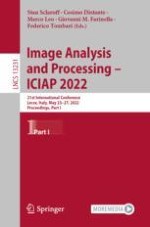2022 | Book
Image Analysis and Processing – ICIAP 2022
21st International Conference, Lecce, Italy, May 23–27, 2022, Proceedings, Part I
Editors: Prof. Stan Sclaroff, Cosimo Distante, Marco Leo, Dr. Giovanni M. Farinella, Prof. Dr. Federico Tombari
Publisher: Springer International Publishing
Book Series : Lecture Notes in Computer Science
